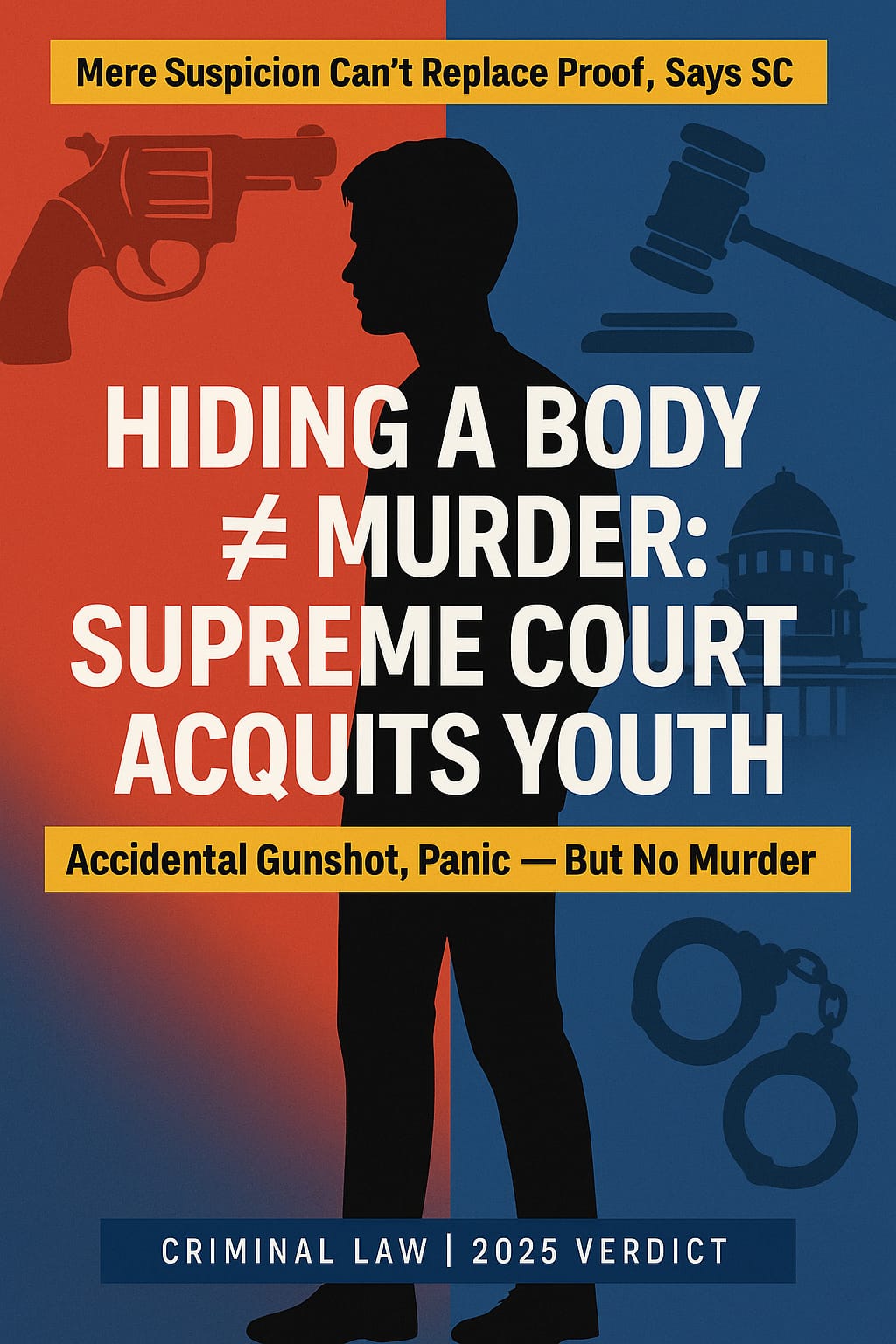Introduction
The Supreme Court of India recently made a significant ruling affirming the integrity of the System of Criminal Justice. The ruling acquitted a medical student of murder charges, ruling that simply hiding a corpse did not constitute competent evidence to infer the commission of the offence of homicide. (Vaibhav v. State of Maharashtra). This important ruling ascertained that if you are charged with murder, to convict an individual based on circumstantial evidence alone, the circumstantial evidence must form a complete chain of evidence independent of any reasonable hypothesis of innocence, especially when the case contains no eyewitness evidence from the prosecution of the crime. The ruling involves the nature of humans after a sudden death, and the legal liabilities of human conduct that results from fright. The ruling affirms a principal of law, that suspicion, no matter how great, is not evidence.
Factual Background
Vaibhav, a first-year student at Bagla Homeopathy Medical College was accused of murdering his friend, Mangesh, who visited him in 2010, and died the next day from a gunshot wound. The gun belonged to Vaibhav’s father, a police officer, and was in their house.The prosecution claimed Vaibhav had intentionally shot Mangesh, and then tried to “cover up” the evidence by cleaning the blood stains, hiding the dead body in a car, and throwing away his blood-stained clothes. The trial court found him guilty under Sections 302 and 201 read with Section 34 of the Indian Penal Code and relevant sections of the Arms Act, and he was sentenced to life imprisonment at the Bombay High Court, which upheld the conviction.Mangesh Vaibhav had always claimed that shooting was an accident, and that he planted in panic and not much thought went into his next actions to cover it up.
Observations from the Supreme Court
In its lengthy judgment, the Supreme Court bench consisting of Justices B.V. Nagarathna and Sanjay Karol took a detailed look at the evidentiary record and overturned the conviction for murder. The Court found that the prosecution did not prove a complete chain of circumstances to arrive just at the conclusion that Vaibhav had committed murder.
1. No Assumption of Liability for Behavior Following an Incident
The Court reaffirmed that although Vaibhav’s actions of concealing the body, cleaning the blood, and lying to the deceased’s family were suspicious and would have been illegal under Section 201 IPC, they were insufficient to establish a murder. The bench tilted to watch:
“A young chap … would have certainly scared to see that his friend has accidentally shot himself … The following conduct may be punishable, but it does not become so unnatural that it could form the basis to convict him for murder without any further evidence.”
2. Circumstantial Evidence Must be Proved Beyond Reasonable Doubt
It reiterated the settled law that when the case rests purely on circumstantial evidence, each and every link of the chain must be proved beyond a reasonable doubt. The Court observed that the medical and forensic evidence was indeed consistent with accidental firing..
3. Lack of Motive and Failure to Establish Actus Reus
The prosecution could not prove any motive for Vaibhav to kill Mangesh. And the prosecution failed to prove who pulled the trigger and whether that act was even, in fact, committed by the accused, leaving reasonable doubt.
Judgment
The Court found Vaibhav not guilty of murder under section 302 IPC and not guilty of charges under the Arms Act but upheld the conviction under Section 201 of IPC – destruction of evidence. However, since he has already spent more than 8 years in custody, no further sentence was imposed.
Conclusion
This ruling underscores one of the cornerstones of criminal law—that a conviction cannot be based upon anything less than proof beyond reasonable doubt, particularly in cases of circumstantial evidence. We acknowledge that the conduct of Vaibhav after the shooting was reckless and unlawful; however, it was not sufficient to prove that he committed murder intentionally.By drawing a distinction between moral culpability and legal guilt, the Supreme Court reiterated that a panic or fear-induced decision to conceal a crime does not establish for the crime charged the actual guilt. It is a cautionary reminder that courts must guard against allowing suspicion to take the place of evidence, particularly when a person’s liberty is concerned.
About the Author
Vidhupriya Sharma is a second-year BA.LLB student at KIIT School of Law, Bhubaneswar, with a strong academic grounding and growing expertise in the field of law. As an aspiring legal professional, she has a deep interest in corporate and business law, driven by the dynamic interplay between legal frameworks and the evolving global economy.
Vidhupriya’s writing reflects a passion for simplifying complex legal concepts and making them accessible to a wider audience—students, professionals, and curious minds alike. Her academic background is complemented by an inquisitive approach to legal research, especially in the areas of mergers & acquisitions, company law, compliance, and financial regulation.
When not immersed in case law or legal debates, she enjoys contributing to law journals, participating in moot courts, and engaging in discussions around contemporary legal issues that shape the business world. Vidhupriya is determined to build a career that bridges academic insight with practical corporate legal practice.

